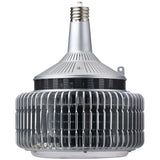High Bay LED Lamp Retrofit: Case Study Demonstrates Benefits
Posted by Dave on for ProLampSales

High bay fixtures that use metal halide lamps are common in warehouses, shops, sports facilities and big box retail stores.
Wattages for metal halide lamps in these applications typically range from 175 watts to 400 watts. Manufacturers are, in 2020, many generations into their lines of LED lamps designed to replace high wattage metal halide.
The wattage for equivalent illumination from LED lamps designed for high bay is generally in the range of 50 watts to 150 watts.
In addition to this 50% to 60% energy cost savings, LED lighting also offers lower maintenance costs. The rated life of metal halide lamps is up to 20,000 hours. For an LED equivalent lamp, rated life can range to 70,000 hours. That translates to at least two fewer re-lamping maintenance operations - in high ceiling buildings where a bucket truck or lift is needed, the maintenance savings with LED add up.
Operationally, restart delay, a common feature of metal halide, is eliminated with instant on LED lamps.
LED Lamp Retrofit: What Are The Costs?
Manufacturers of LED lamps designed to replace metal halide generally offer two installation options:
- UL Type A Ballast Compatible
- UL Type B Ballast Bypass with Line Voltage to the Socket
UL Type A Installation
For ease of installation and lower overall install expense, UL Type A lamp retrofits are the choice. Simply remove the metal halide lamp and install the LED.
However, some compromises are inherent in this type of installation. Because the lamps operate directly off the existing metal halide ballast, the efficacy of the LED lamp may be degraded by an inefficient ballast. In addition if the ballast is old, it may stop working long before the LED lamp. This will require an additional cost.
UL Type B Installation
An electrician is required to remove the existing ballast and re-wire line voltage directly to the socket. The advantages of this approach is eliminating compatibility issues with a ballast. This is the simplest total system with excellent LED efficacy. Disadvantages include the need to install a fuse to avoid injury if future maintenance staff reinstall metal halide lamps and the higher overall install cost compared to UL Type A.
Ultimately, the decision for which type of LED installation to use depends on an assessment of the existing ballast (is it relatively new and efficient or old and inefficient) and on the budget.
High Bay LED Lamp Retrofit Case Study
The Lighting Research Center (LRC) at Rensselaer Polytechnic Institute conducted a study evaluating installation issues and performance of a high bay LED lamp retrofit in a warehouse. The retrofit in the study was for a UL Type B ballast bypass type installation.
The objectives of the study were:
- Evaluate issues related to ease of installation
- Evaluate worker attitudes about the effectiveness of the LED lighting
- Compare the energy performance before and after the installation of LED
Before Retrofit
- Lamps: Philips MH400/U/ED28
- Lumens: 24,000
- Color Temp: 4000K
- CRI: 63
- Rated Life: 20,000 hrs
After Retrofit
- Lamps: Light Efficient Design LED-8090M40-A
- Lumens: 15,000
- Color Temp: 4000K
- CRI: 84
- Rated Life: 50,000 hrs
Retrofit steps (all performed by an electrician):
- Remove existing lamps
- Remove existing ballasts
- Rewire line voltage to the sockets
- Install a surge protector to safeguard the LED electronics
- Install a fast-acting fuse to protect against explosion if metal halide lamps are reinstalled in the future
The electrician reported to the researches that it took approximately 15 minutes per fixture to complete all of the steps. A bucket truck was used to reach the fixtures.
Results
- The LED retrofitted fixtures increased measured light levels compared to metal halide by a factor of 3x.
- The existing fixtures had prismatic lenses and they were used with the new LED lamps which provided excellent diffuse light distribution.
- Workers reported a perception of higher light levels and brighter working conditions after the LED retrofit.
- The annual energy savings was estimated at 60% after the LED retrofit.
For further details on the study, download the complete LRC study.
- Posted in HID & Metal Halide, LED
Featured Products (View All)
0 Comments




